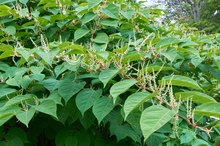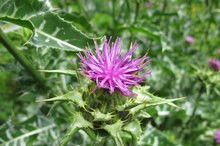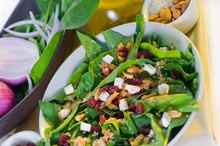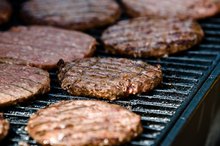What Foods Have High EGCG?
Epigallocatechin gallate, or EGCG, present in a limited number of plant-based foods and beverages, is not only a powerful weapon against disease but also a source of energy and a way to stimulate your metabolism 6. This potent antioxidant has a wide array of medicinal properties, including the ability to inhibit the proliferation of some forms of cancer. EGCG also appears to protect against other health threats, including cardiovascular disease.
Potent Antioxidative Properties
Kohlstadt points out that EGCG has significantly higher antioxidant activity than either vitamins C or E, both of which are regarded as valuable antioxidants. Research by the University of Kansas in the late 1990s showed that EGCG is not only superior in antioxidative potency to vitamins C and E but also twice as effective as resveratrol, found in grape skins and red wine, in scavenging free radicals. EGCG also inhibits the proliferation of cells -- a particularly useful property in fighting the spread of cancer.
Green, Oolong and Black Teas
What Are the Benefits of Japanese Knotweed?
Learn More
However, differences in processing methods result in widely varying EGCG content among teas. Because the leaves for brewing green tea are unfermented and thus less oxidized, green tea boasts the highest level of EGCG. Green tea leaves have 7.1 grams of EGCG per 100 grams, compared with 3.4 grams for oolong and 1.1 grams for black tea leaves. The brewed teas themselves have 77.8 milligrams of EGCG per 100 grams for green tea, 34.5 milligrams for oolong and 9.3 milligrams for black tea.
- However, differences in processing methods result in widely varying EGCG content among teas.
- The brewed teas themselves have 77.8 milligrams of EGCG per 100 grams for green tea, 34.5 milligrams for oolong and 9.3 milligrams for black tea.
Carob Flour
Also very high in EGCG content is carob flour, a cocoa-like substance derived from the ground pods of the carob plant, or Ceratonia siliqua. Carob flour is used in the production of caffeine-free chocolate-like confections and other cocoa-type products. Carob flour has 109.5 milligrams of EGCG per 100 grams, according to data from the U.S. Department of Agriculture.
Other Foods
Lipton Tea and Antioxidants
Learn More
A handful of nuts and fruits contain measurable amounts of EGCG. Although their EGCG content is relatively small, these foods contain a wide array of other nutrients that make them attractive from a nutritional standpoint. Included in this group are pecans with 2.3 milligrams of EGCG per 100 grams, filberts or hazelnuts with 1.1 milligrams, raw cranberries with 1 milligram and pistachios with 0.4 milligrams per 100 grams, according to data from the USDA.
Related Articles
References
- The 150 Most Effective Ways to Boost Your Energy; Jonny Bowden
- University of Maryland Medical Center: Green Tea
- Food and Nutrients in Disease Management; Ingrid Kohlstadt
- University of Kansas Press Release: More Proof That Green Tea May Postpone Cancer, Heart Disease
- USDA: Database for the Flavonoid Content of Selected Foods, Release 3.1
- Phytochemicals: Epigallocatechin Gallate
- Lee, M. S., Kim, C. T., & Kim, Y. (2009). Green tea (â)-epigallocatechin-3-gallate reduces body weight with regulation of multiple genes expression in adipose tissue of diet-induced obese mice. Annals of Nutrition and Metabolism, 54(2), 151-157.
- Dulloo, A. G., Duret, C., Rohrer, D., Girardier, L., Mensi, N., Fathi, M., ... & Vandermander, J. (1999). Efficacy of a green tea extract rich in catechin polyphenols and caffeine in increasing 24-h energy expenditure and fat oxidation in humans. The American journal of clinical nutrition, 70(6), 1040-1045.
- Cardoso, G. A., Salgado, J. M., Cesar, M. D. C., & Donado-Pestana, C. M. (2013). The effects of green tea consumption and resistance training on body composition and resting metabolic rate in overweight or obese women. Journal of medicinal food, 16(2), 120-127.
- Bhagwat, S., Haytowitz, D. B., & Holden, J. M. (2011). USDA database for the flavonoid content of selected foods, Release 3.1. Beltsville: US Department of Agriculture, 03-1.
Writer Bio
Don Amerman has spent his entire professional career in the editorial field. For many years he was an editor and writer for The Journal of Commerce. Since 1996 he has been freelancing full-time, writing for a large number of print and online publishers including Gale Group, Charles Scribner’s Sons, Greenwood Publishing, Rock Hill Works and others.









